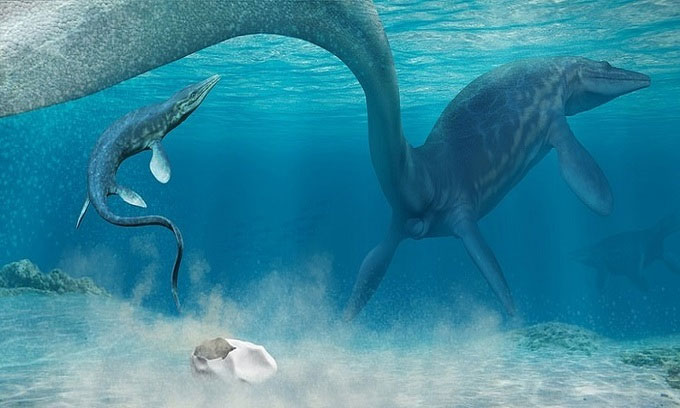Found the world's largest reptile egg fossil
Geologists at the University of Texas found the 28cm egg belonged to a 7m-long sea monster 66 million years ago in Antarctica.

The oversized soft-shelled egg of the ancient sea lizard Antarcticoolithus bradyi is second only to the extinct Madagascar bird eggs. Dr Lucas Legendre, who led the research, said it resembles the lizard's egg and the snake the most.

Simulating the offspring of Antarcticoolithus bradyi emerging from eggshell. (Photo: Fox).
In addition to its staggering size, the findings also go against the widespread notion that giant marine animals existed before extinct dinosaurs did not lay eggs. According to Professor Julia Clarke, co-author of the study, the egg nearly as intact as the football changed the understanding of the living creatures of the time. The size and thin crust of the egg suggest that A. bradyi reproduces in the way of an ovum , meaning that the eggs develop inside the mother's body and hatch right after birth.
The egg was unearthed in the Lopez de Bertodano formation on the Seymour island in the Antarctic peninsula. In prehistoric times, the area was ice free and much warmer, with forests covering much of the mainland. Many researchers hypothesize that this is an ideal breeding ground because shallow water provides a peaceful environment for the young to grow.
The egg can hatch at the sea or be buried on the beach, depending on the ability of the mother. The giant sea reptile is too heavy to support its body weight on land. Laying eggs requires reptiles to twist the tail and sink most of the body to borrow the lift of the water. The team cannot draw firm conclusions.
Fossil eggs look like a deflated balloon unearthed by Chilean scientists in 2011 but there is no classification label in the collection of the Chilean Museum of Natural History for nearly a decade. Using a microscope to study the specimen, Dr. Legendre discovered several layers of membranes to help confirm the fossil is really an egg. Research by Legendre et al. Enhances understanding about the size of soft shell eggs. They published their findings in the journal Nature on June 17.
- The big sea monster never seen
- Fossil sea monsters 75 million years of raw marks the enemy's teeth
- Detecting ugly reptile fossils, head full of humps
- Found fossils of marine reptiles carrying embryos
- The strange reptile has hundreds of needle-like teeth
- Find new flying reptile fossils
- The 70-million-year-old plesiosaur fossil resembles the Loch Ness monster
- Unexpected fossil detection of marine reptiles has 4 nostrils
- Discovered new species of non-foot reptile
- Traces of ancient reptiles have never been discovered
- Big ocean killer with bus living with dinosaurs
- The boy took two years to restore the 200 million-year-old dragonhead fossil
 Discovered an ancient centipede fossil 99 million years old
Discovered an ancient centipede fossil 99 million years old Discovered bat-like dinosaurs in China
Discovered bat-like dinosaurs in China Discovered a 200-year-old bronze cannon of the coast
Discovered a 200-year-old bronze cannon of the coast Discover 305 million-year-old spider fossils
Discover 305 million-year-old spider fossils